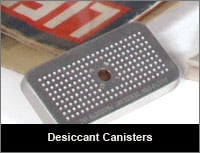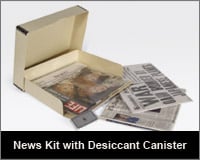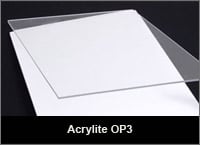| Newsletter • Issue #11 | To view this email as a web page, click here |
| If you haven't already, add [email protected] to your address book to assure delivery of requested newsletters. | |
 |
|||||||||||||||||||||||||||||||||||
|
|||||||||||||||||||||||||||||||||||
Dear Madam or Sir,Thank you for receiving the latest Archival Methods Newsletter. We hope you find the information useful. In this issue:Learn to:Properly use Proof BoxesDiscover a Tip:The archival applications of desiccant canistersTerm Definition:AcrylicQ&A Session:Framing Tips
|
Learn to: Properly use Proof BoxesIn some situations, photographers and collectors may not necessarily want to store photographs for extended periods of time. While short-term storage of photos might not, by default, require the use of preservation-grade archival products, it can still be extremely beneficial to make use of storage items that offer an aesthetically proper and professional-looking presentation. With this in mind, the use of proof boxes should be considered. These enclosures will provide the right level of protection for short-term on-site storage, and also allow for a simple and elegant presentation in a variety of settings. Applications could range from a photography student presenting his work for a final project to a freelance photographer looking to wow a recruiter at her latest job interview.
The understated strength of black proof boxes These enclosures are available in a wide variety of sizes, both small (7" x 5" x 1") and large (19" x 13" x 1"). The exterior material features a two-piece construction, double-wall thickness and is coated in textured black acrylic, while the interior boasts a black paper lining. These characteristics help protect proofs from dirt and dust. Additionally, it's important to note that the larger models of these boxes can be particularly useful when presenting larger prints at a gallery exhibition or similar event.
Using print pack proof boxes These boxes have a clamshell hinge that is reinforced so it won't buckle under any pressure from regular opening and closing. The exterior is made of either white or black latex reinforced cover stock and features a linen texture finish. Additionally, the boxes can hold up to 250 un-sleeved photo proofs. A note on proof boxes' preservation abilities However, given their usefulness for the purposes of presentation and short-term storage, these items must still be taken into consideration by those looking for an ideal showcasing solution for their best photo proofs. Brafton written article for www.archivalmethods.com 04/20/12 Discover a Tip:
| ||||||||||||||||||||||||||||||||||
 |
While a fair amount of the potential damage humidity can bring to artwork and other items can be negated by regulating the temperature in a room, it's also quite important to make use of the right archival products. Desiccant canisters can be particularly useful to help alleviate humidity in archival-grade storage items and enclosures.
A brief explanation of desiccant canisters and silica gel
Those who are novices to proper preservation and archival techniques might scratch their heads and say, "What?" when desiccant canisters are mentioned. However, they're not at all complicated. These items are simply metal or plastic cases
(with 2" x 4" and 2¼" x 4¼" dimensions, respectively), which contain silica gel.
The gel is a moisture- and humidity-eliminating agent. According to the Material Safety Data Sheet for silica gel, which is authorized by the Occupational Safety and Health Administration (OSHA) and American National Standards Institute (ANSI), it is 100 percent silicon oxide. Although inhalation of the exposed product can irritate the human respiratory system, it's perfectly safe for use when kept in its container (as it should always remain).
 |
Benefits of desiccant canisters
A collector could use desiccant canisters in conjunction with a variety of different archival-grade enclosures. These include museum cases and Onyx portfolios.
The canister is placed inside the enclosure, and it absorbs moisture and water vapor that develops within the container. Each of these items can protect up to three cubic feet of space from detrimental humidity, so you can use more than one canister per container if need be.
Steps for reusing
Arguably, the greatest benefit of desiccant canisters is that they can be reused even after they might seem to have lost their moisture-reducing abilities. This can be discerned if the gel has turned pink (it's visible through a small window in the center of the item). Check the desiccant canister periodically (every 2 to 3 months) to ensure it is working properly and whether it needs to be reactivated.
With the metal canister, one can place it in a warm vented oven to restore the desiccant properties of the silica gel. Plastic canisters, meanwhile, can be restored in a microwave. Be sure to follow the instructions included with these items regarding time and temperature, to avoid any unnecessary complications.
Brafton written article for www.archivalmethods.com 04/20/12
A plastic noted for transparency, light weight, weather resistance, color fastness and rigidity. It is also important in preservation because of its stability/resistance to chemical change over time. This is not a characteristic found in all plastics. Acrylics are available in sheets, films, and resin adhesives. Common trade names for a sheet of acrylic are; Perspex, Lucite and Plexi-Glass.
 |
Acrylite OP3 is highly recommended for archival framing. It provides added protection against harmful ultraviolet rays that can fade your images over time; each sheet is 1/8'' thick and filters out 98% of UV rays.
Q: I have recently purchased my first signed and numbered print and would like to frame it, but I do know what to look for in the way of matting and backing. I want to get the right material to preserve the print correctly and have been told to mat and frame it using "Museum Quality". Where do I begin, what is the proper material to use?
A: "Museum Quality" is not a specific specification. It simply refers to the use of the proper materials for the artwork in question. In order to properly preserve and frame your prints the following protects are recommended.
| Framing Essentials | |
Selecting a 100% cotton (rag board) or conservation board for the window mat will provide an acid and lignin free option. The mat should consist of two pieces of board; one with a window opening and the other is backing board that the print is attached to with photo (mounting) corners. The two boards should also be hinged for added support and stability. Linen Tape works well for hinging of mats. |
|
When framing the artwork the glass or plastic should be light filtering. UV Rays can cause fading of the print(s). Acrylite OP3 is a recommended solution. |
|
Another added structural backing such as Acid Free Foamboard is optional but will add additional structural strength (highly recommended for larger prints). |
|
Aluminum Frames can be used to complete the “Museum Quality” solution for displaying of your prints. Be sure to keep in mind the channel dimension of the frame; it must be able to accommodate the thickness of the matted print, backboard and acrylite or other glazing. |
If you have any questions, please feel free to e-mail them to [email protected] or visit us on Twitter, FaceBook or LinkedIn.